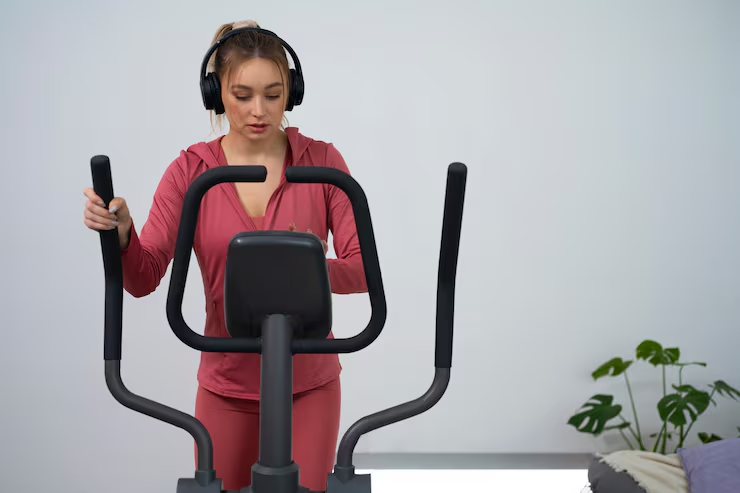Weight loss is a journey that requires the right combination of commitment, nutrition, and physical activity. While there are many machines and routines available, few match the efficiency and versatility of elliptical exercises for weight loss. This low-impact cardio workout is not only easier on your joints compared to running or HIIT, but it also provides a full-body workout that burns calories, tones muscles, and improves cardiovascular health.
If you’ve been searching for an effective way to drop weight without stressing your knees or hips, the elliptical trainer could be your new best friend. In this article, we dive deep into everything you need to know about elliptical exercises for weight loss, from top tips and benefits to frequently asked questions and expert advice to help you achieve your goals faster.
Let’s explore how to make the most out of every session on the elliptical and sculpt the lean, healthy body you deserve.

Elliptical Exercises for Weight Loss: Burn Fat and Tone Muscles
Elliptical exercises for weight loss are an effective way to burn calories, tone muscles, and improve cardiovascular fitness. The low-impact design of the elliptical makes it gentle on joints while still providing a challenging full-body workout. By using both the pedals and handlebars, you engage your legs, glutes, arms, and core simultaneously, making these exercises highly efficient for fat burning. Regular elliptical workouts can help you achieve weight-loss goals safely and effectively.
One of the key benefits of elliptical exercises for weight loss is their versatility. You can adjust resistance, incline, and speed to increase intensity, or incorporate techniques like backward pedaling and interval training to target different muscle groups. This variety prevents workout plateaus, keeps your routine engaging, and maximizes calorie burn. These exercises also enhance endurance, improve balance, and strengthen stabilizing muscles, supporting overall fitness and long-term weight management.
To get the best results, aim for 30–45 minutes per session, 3–5 times a week, and combine with strength training or stretching. Including elliptical exercises for weight loss in your regular fitness plan ensures a full-body, high-energy workout that promotes fat loss, strengthens muscles, and boosts overall health.
How Does Elliptical Exercises for Weight Loss Work
Elliptical exercises for weight loss are designed to provide a full-body, low-impact workout that burns calories and strengthens muscles. The elliptical machine combines arm and leg movements, engaging multiple muscle groups at once, including the legs, glutes, arms, and core. This simultaneous engagement increases energy expenditure, making elliptical exercises for weight loss highly effective for shedding pounds while minimizing joint stress.
These exercises work by maintaining an elevated heart rate throughout the session, which boosts cardiovascular fitness and stimulates fat-burning metabolism. Adjusting resistance and incline allows you to target specific muscle groups and intensify workouts, while incorporating techniques like interval training or backward pedaling further enhances calorie burn. Elliptical exercises for weight loss also improve endurance and stamina, helping you perform other physical activities more efficiently.
To maximize results, aim for 30–45 minutes per session, 3–5 times per week, and combine elliptical workouts with a balanced diet. Using elliptical exercises for weight loss consistently ensures effective fat reduction, muscle toning, and long-term fitness benefits while supporting overall health and wellness.
Top Elliptical Tips for Weight Loss
Use Interval Training (HIIT) on the Elliptical

Interval training, or High-Intensity Interval Training (HIIT), on the elliptical is one of the most effective ways to burn calories and accelerate fat loss. By alternating between periods of intense effort and moderate recovery, you challenge your cardiovascular system and boost metabolism. Incorporating HIIT into your routine makes elliptical exercises for weight loss more efficient, as it maximizes calorie burn in a shorter amount of time compared to steady-state cardio.
During a HIIT elliptical session, you can increase resistance and speed for 30–60 seconds, followed by a slower, moderate pace for recovery. This cycle not only engages your legs, glutes, and core muscles but also elevates your heart rate, improving endurance and promoting fat loss. The variation in intensity keeps workouts exciting and prevents plateaus, making it easier to stay motivated and consistent with your fitness goals.
To get the best results, aim for 15–30 minutes of HIIT on the elliptical, 3–5 times per week. Combining interval training with other elliptical exercises for weight loss creates a dynamic, full-body workout that strengthens muscles, burns calories, and accelerates weight loss effectively.
What to Do: Alternate between high-intensity bursts (60–90 seconds) and low-intensity recovery (90–120 seconds) for 20–30 minutes.
Benefit: Maximizes calorie burn and boosts metabolism for hours after your workout (afterburn effect).
Ingredients:
A timer or HIIT app
Pre-set interval programs on the machine
Engage Both Upper and Lower Body
One of the key advantages of using an elliptical machine is its ability to engage both the upper and lower body simultaneously. By utilizing the handlebars while pedaling, you work your arms, shoulders, chest, and back in addition to your legs and glutes. This full-body engagement makes elliptical exercises for weight loss more effective, as it increases calorie burn and improves overall muscle tone.
Engaging multiple muscle groups also enhances cardiovascular fitness and boosts metabolism. When both the upper and lower body are active, the body works harder to maintain rhythm and coordination, which elevates heart rate and maximizes fat-burning potential. This approach ensures that your workout is efficient, targeting more calories in less time while also promoting balanced muscle development and endurance.
To optimize results, maintain a steady pace while actively pushing and pulling the handlebars during your elliptical session. Incorporating upper-body engagement into your routine alongside other elliptical exercises for weight loss creates a dynamic, high-energy workout that strengthens muscles, enhances calorie burn, and accelerates weight-loss goals effectively.
What to Do: Use the moving handlebars to push and pull while pedaling with your legs.
Benefit: Burns more calories and tones your arms, chest, and back along with your glutes, hamstrings, and quads.
Ingredients:
Dual-action elliptical machine
Proper posture and form
Add Resistance and Incline

Adding resistance and incline to your elliptical workout is a highly effective way to boost calorie burn and target different muscle groups. Increasing resistance challenges your legs, glutes, and core, while using the incline engages your hamstrings and lower back more intensely. This makes elliptical exercises for weight loss more efficient, helping you achieve faster results compared to standard flat workouts.
Incorporating incline and resistance not only strengthens muscles but also improves cardiovascular endurance. The added challenge forces your body to work harder, which elevates your heart rate and enhances metabolism. Over time, these adjustments help tone your lower body while promoting overall fat loss, making your workouts more dynamic and engaging.
For optimal results, alternate between moderate and high resistance or adjust the incline periodically during your session. Pairing resistance and incline with other elliptical exercises for weight loss creates a full-body, calorie-burning workout that strengthens muscles, improves stamina, and supports effective weight management.
What to Do: Gradually increase the resistance and incline level every 5 minutes.
Benefit: Builds muscle while burning fat, making your body more efficient at weight loss over time.
Ingredients:
Elliptical with incline/resistance settings
Workout plan with progressive overload
Monitor Your Heart Rate
Monitoring your heart rate during elliptical workouts is essential for maximizing fat-burning and achieving weight-loss goals. By keeping track of your heart rate, you can ensure that you are exercising within the optimal target zone, which efficiently burns calories and improves cardiovascular health. Incorporating heart rate monitoring into your routine makes elliptical exercises for weight loss more precise and effective.
Maintaining the right heart rate ensures that your workout intensity is sufficient to challenge your body without overexertion. A steady, elevated heart rate increases calorie burn and boosts metabolism, while preventing fatigue and injury. It also helps you gauge the effectiveness of your workout, allowing you to adjust resistance, speed, or incline to stay within your ideal fat-burning range.
To use this method, check your pulse periodically or use a heart rate monitor built into most elliptical machines. Combining heart rate monitoring with other elliptical exercises for weight loss creates a structured, efficient, and results-driven workout that strengthens muscles, improves endurance, and accelerates fat loss.
What to Do: Stay in your fat-burning zone (typically 60–70% of max HR) or cardio zone (70–85%).
Benefit: Ensures you are working hard enough for fat loss without overtraining.
Ingredients:
Heart rate monitor
Elliptical console with heart rate sensors
Mix It Up with Backward Pedaling

Incorporating backward pedaling into your elliptical routine is a simple yet effective way to target different muscle groups and increase calorie burn. While forward motion primarily engages your quads and calves, pedaling backward emphasizes the hamstrings, glutes, and lower back. This variation makes elliptical exercises for weight loss more dynamic, helping you tone your entire lower body while boosting overall workout efficiency.
Backward pedaling also challenges your coordination and balance, forcing your core muscles to work harder to maintain stability. This added engagement elevates your heart rate and increases calorie expenditure, supporting fat loss and cardiovascular fitness. The change in movement prevents your body from adapting too quickly to the same routine, reducing the likelihood of hitting a weight-loss plateau.
To get the most benefit, alternate between forward and backward pedaling during your session. Combining backward pedaling with other elliptical exercises for weight loss creates a full-body, high-energy workout that strengthens muscles, burns calories, and accelerates weight-loss results effectively.
What to Do: Pedal in reverse for 1–2 minutes every 10 minutes.
Benefit: Targets different muscle groups like hamstrings and calves for a more balanced lower body workout.
Ingredients:
Elliptical with bi-directional movement
Comfortable shoes with good grip
Set Time-Based or Calorie Goals
Setting specific time-based or calorie goals during your elliptical workouts is a powerful strategy to stay motivated and track progress. By aiming to exercise for a certain duration or burn a targeted number of calories, you create measurable benchmarks that encourage consistency. This approach makes elliptical exercises for weight loss more structured and results-driven, helping you stay committed to your fitness journey.
Time-based goals allow you to gradually increase workout duration, improving endurance and cardiovascular health. Calorie-focused targets ensure that each session is productive, maximizing fat-burning potential. Combining these methods helps maintain workout intensity and prevents plateaus, making your elliptical routine more effective for weight loss and overall fitness improvement.
To implement this, decide on a realistic time or calorie target before starting your session. Monitor your progress using the elliptical machine’s display or a fitness tracker. Pairing goal-setting with other elliptical exercises for weight loss creates a focused, efficient, and motivating workout routine that strengthens muscles, burns calories, and accelerates fat loss.
What to Do: Set a daily or weekly goal for duration or calories burned.
Benefit: Helps track progress and maintain consistency, which is crucial for weight loss.
Ingredients:
Fitness tracker or app
Realistic goal (e.g., 300 calories/session, 5 days a week)
Stay Hydrated and Fuel Properly
Staying hydrated and fueling your body properly are crucial for maximizing the benefits of elliptical workouts. Proper hydration ensures your muscles perform efficiently, prevents fatigue, and supports metabolism during exercise. Drinking water before, during, and after your session enhances endurance, allowing you to perform elliptical exercises for weight loss more effectively and safely.
Equally important is consuming the right nutrients to fuel your workout. Eating a balanced snack with carbohydrates and protein before exercising provides energy and helps maintain muscle strength. Post-workout nutrition aids recovery and supports fat-burning efforts. When your body is properly fueled, you can maintain intensity, improve performance, and achieve better results from your elliptical routine.
To get the most from your workouts, sip water regularly and plan small, healthy meals around your exercise schedule. Combining hydration and proper fueling with other elliptical exercises for weight loss ensures a safe, high-energy workout that boosts calorie burn, strengthens muscles, and promotes effective weight management.
What to Do: Drink water before, during, and after your workout. Have a light carb-protein snack 30–60 mins before.
Benefit: Increases energy levels and endurance during exercise, prevents dehydration.
Ingredients:
Water bottle
Pre-workout snack (banana with peanut butter, smoothie)
Incorporate Recovery Days
Incorporating recovery days into your workout schedule is essential for achieving long-term results with elliptical exercises for weight loss. Rest days allow your muscles to repair and rebuild after intense sessions, preventing overtraining and reducing the risk of injury. Without proper recovery, performance can plateau, and fatigue may hinder calorie-burning efforts.
Active recovery, such as light stretching, yoga, or a gentle walk, can complement your elliptical routine. These activities promote blood flow, reduce muscle soreness, and maintain flexibility while giving your body the time it needs to recuperate. Incorporating recovery days ensures that each elliptical session is performed with optimal energy, allowing you to maintain intensity and effectiveness for fat loss.
For best results, schedule 1–2 recovery days per week depending on your workout intensity. Combining recovery with regular elliptical exercises for weight loss enhances muscle strength, improves endurance, and supports sustainable, long-term weight management.
What to Do: Take 1–2 rest or active recovery days weekly with light stretching or yoga.
Benefit: Prevents burnout and injury, allowing your body to rebuild and burn fat more effectively.
Ingredients:
Rest or low-intensity plan
Foam roller or yoga mat
Track Progress and Stay Consistent
Tracking your progress and maintaining consistency are essential for achieving results with elliptical exercises for weight loss. By monitoring metrics such as duration, distance, resistance, and calories burned, you can see improvements over time and adjust your workouts to stay challenging. This not only keeps you motivated but also ensures that each session is purposeful and effective.
Consistency is key to building endurance, strength, and fat-burning capacity. Regular elliptical workouts, performed at least 3–5 times per week, help elevate your metabolism and tone muscles while maximizing calorie expenditure. Sticking to a consistent routine prevents setbacks and accelerates your weight-loss journey, making your fitness goals more attainable.
To track progress, use a fitness app, journal, or the elliptical machine’s built-in monitor. Combining progress tracking with other elliptical exercises for weight loss ensures a structured, goal-oriented approach that strengthens muscles, boosts metabolism, and supports long-term fat loss.
What to Do: Use fitness apps or a journal to track weight, calories burned, and session duration.
Benefit: Builds motivation and helps you identify what’s working.
Ingredients:
Fitness journal or app (MyFitnessPal, Fitbit)
Weekly review schedule
Benefits of Elliptical Exercises for Weight Loss
Full-body workout: Engages both upper and lower body muscles
Low-impact: Safer on joints than running or jumping
Burns major calories: 270–400 calories in 30 minutes
Customizable intensity: Ideal for all fitness levels
Boosts endurance: Improves stamina and heart health
Fat burning: Targets the optimal heart rate zones
Increases metabolism: Especially with interval training
Enhances mood: Releases endorphins to reduce stress
Efficient workouts: Combine strength and cardio in one session
Elliptical Weight Loss Routine (Sample Weekly Plan)
| Day | Workout | Duration | Focus |
|---|---|---|---|
| Monday | HIIT Intervals | 30 mins | Fat Burn |
| Tuesday | Steady State Cardio | 45 mins | Endurance |
| Wednesday | Backward Pedal & Resistance | 30 mins | Lower Body |
| Thursday | Active Recovery | 20 mins | Mobility |
| Friday | HIIT Intervals | 30 mins | Metabolism Boost |
| Saturday | Long Moderate Session | 50 mins | Calorie Burn |
| Sunday | Rest or Light Walk | – | Recovery |
Conclusion

Elliptical exercises for weight loss offer an incredibly effective, joint-friendly, and versatile way to burn fat and improve your fitness. Whether you’re a beginner looking for low-impact options or someone wanting to take your cardio to the next level, the elliptical machine provides everything you need in one powerful workout.
By following the tips shared in this article—such as integrating intervals, using resistance, staying consistent, and tracking your progress—you can turn the elliptical into your ultimate fat-burning machine. Just 30–45 minutes a day can lead to noticeable results in just a few weeks, especially when combined with good nutrition and proper recovery.
Remember, weight loss is a marathon, not a sprint. Stay motivated, stick to the plan, and let elliptical exercises for weight loss guide you to a healthier, leaner, and more confident version of yourself. You’ve got this!
FAQs
Q1. How does elliptical exercise help with weight loss ?
Elliptical workouts burn calories, increase heart rate, and improve metabolism. When paired with a proper diet, they create a calorie deficit, leading to fat loss. Because it targets the whole body, it maximizes efficiency in shorter periods.
Q2. What makes elliptical training better than other cardio options ?
Unlike treadmills or running, elliptical machines provide a low-impact workout that reduces stress on joints while still offering high-calorie burn and full-body engagement. It’s ideal for people recovering from injury or looking for safer alternatives to high-impact cardio.
Q3. When is the best time to do elliptical workouts for weight loss ?
While any time is beneficial, many find morning workouts help kickstart metabolism and build consistency. However, the best time is the one you can commit to regularly. Consistency matters more than timing.
Q4. Why should I choose an elliptical over a treadmill ?
Ellipticals reduce joint strain while still burning a high number of calories. They also incorporate upper body motion, making it a more complete workout compared to a treadmill, which primarily targets the lower body.
Q5. What’s the ideal duration for an elliptical session for fat loss ?
A 30 to 45-minute session, 4–5 times per week, is ideal for weight loss. Beginners can start with 20-minute sessions and gradually increase as fitness improves. Combining with intervals and resistance maximizes results.

